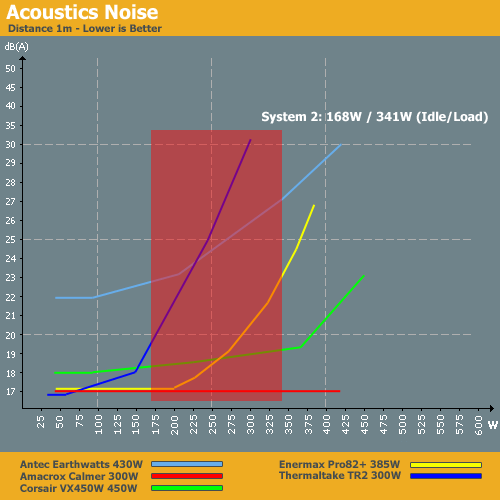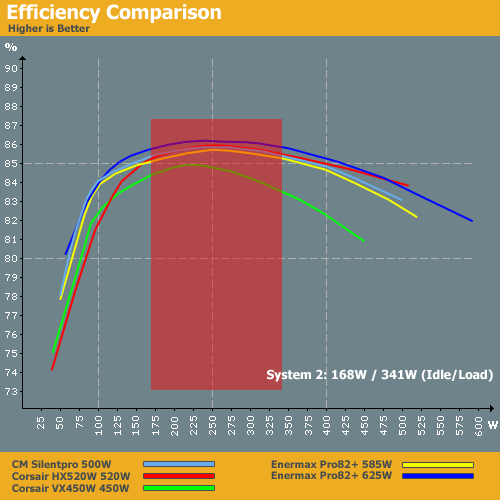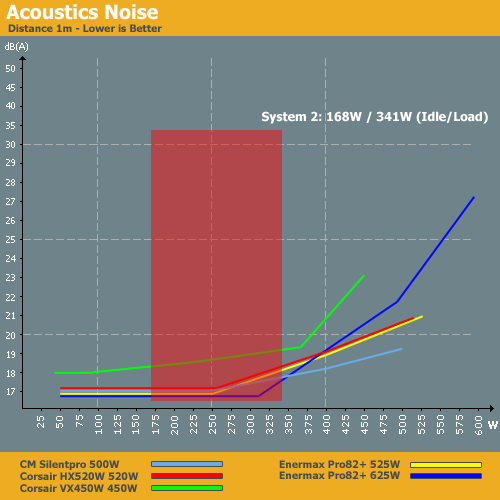Debunking Power Supply Myths
by Christoph Katzer on September 22, 2008 3:00 AM EST- Posted in
- Cases/Cooling/PSUs
PSUs for Midrange Systems
Our midrange system opens up a lot more in the way of potential power supplies, as there are far more manufacturers building 400W to 500W PSUs. Our idle power consumption in this case is 168W, which is quite high when compared to the 120W a high-end system would have used a few years back (i.e. AMD Athlon 64 4000+ and NVIDIA GeForce 7800 GTX under full load). However, times change and we see increased power requirements along with performance improvements.
Our selection of power supplies uses the same criteria as before. We will also see how our entry-level power supplies and all this sort of system.
- Cooler Master Silent Pro (500W) actively cooled
- Corsair HX520W (520W) actively cooled
- Corsair VX450W (450W) actively cooled
- Enermax Pro82+ (585W) actively cooled
- Enermax Pro82+ (625W) actively cooled


In terms of efficiency as well as the ability to supply sufficient power, all of the power supplies are able to run this midrange setup except for the 300W Thermaltake unit. The Antec Earthwatts has been around for a while, so it's not surprising that it doesn't perform as well as newer models, but it still delivers decent if not great efficiency. Noise levels are a different matter, and we would be inclined to avoid most of the entry-level PSUs. If noise isn't a consideration, all but the Antec will work; however, the Corsair VX450W performs best out of these units in so we will carry it along to the next level and include it with the midrange offerings.
Efficiency is Not the Issue

With the addition of some higher performing power supplies, efficiency clearly shouldn't be the overriding concern for a computer like our midrange system. The Corsair VX450W doesn't look as good in this graph, although 83% efficiency certainly isn't anything to cry about. The newer models all reach efficiency of around 85% to 86% throughout the midrange system load. Comparing the two scenarios, outside of PSUs that simply can't provide enough power it's not necessary to move up to a higher performance power supply. You want to look at other aspects such as features, warranty, and noise levels before making a decision.

In terms of noise levels, all of these units perform very well and can provide a quiet computing environment. We also see a clear separation between the entry-level PSUs in the midrange PSUs in this chart, since the midrange units are running a 75% load at worst. Again, if you've had the mindset that 600W and higher PSUs are required for modern midrange systems, the above charts should help dispel that myth. If you can find a good quality 400W PSU, it can easily power a midrange system. However, 500W PSUs generally make the best fit, as they provide optimal efficiency and lower noise.










98 Comments
View All Comments
Christoph Katzer - Monday, September 22, 2008 - link
Yes I guess that was the problem. Thanks for pointing that out!ViRGE - Monday, September 22, 2008 - link
Christoph, thanks for the excellent article. There is one thing I noticed however that has me a bit confused. In a few of your video card tests, you have the cards pulling upwards of 100 watts from the PCIe slot. It has been my understanding, and is mentioned in AT's X38 chipset article*, that the limit for a PCIe slot is 75W. Your results put this value in contention, so I'm not sure what to believe at this point.Is it that I am mistaken that the limit is 75W, or are your video cards pulling too much power from the slot, or is there a problem with the data?
Christoph Katzer - Monday, September 22, 2008 - link
Thanks. The data is correct since the cards draw power through the PCIE slot and the additional PEG connectors (6-pin or 8-pin). Towards the end of the article you will find a list which card drew how much power from the PCIE slot and the PEG connector. 75 watts is however correct for the older PCIE slots, PCIE2.0 can draw up to 150 watts.mobutu - Monday, September 22, 2008 - link
Where is AMD 4850?Also almost all the graph cards used are kind of old, previous generation.
Dobs - Monday, September 22, 2008 - link
Here is a link to a comprehensive list of all graphics cards.Dobs - Monday, September 22, 2008 - link
damn... link didn't workCopy and paste :)
http://archive.atomicmpc.com.au/forums.asp?s=2&...">http://archive.atomicmpc.com.au/forums.asp?s=2&...
Clauzii - Monday, September 22, 2008 - link
Nice lists, thanks :)Christoph Katzer - Monday, September 22, 2008 - link
As stated I didn't have all of the new stuff here and this article anyway focuses primarily on power supplies and how to choose them and not the power consumption of the components... but it might come soon, who knows.LTG - Monday, September 22, 2008 - link
>>our labs don't have the latest GPUs available for testingIsn't this kind of a bad thing for a site with so many enthusiast readers?
First two caveats:
1) There are a lot of article bashers out there who nit-pick, give rude feedback, or are just plain wrong, I don't support these guys or want to be one.
2) The article written was very good and helpful, thank you.
However it doesn't matter that the article "primarily focused on how to choose power supplies".
- Leaving out a GTX 280 was a big omission. Even better to have an stock OC'd product.
- Leaving out very basic overclock numbers was a big omission. For example it's very common for readers to have an Intel QC clocked at 3.6Ghz since it's so doable.
Having the last two data points would be very helpful for those building top systems, and would even be interesting for those who are not.
7Enigma - Monday, September 22, 2008 - link
As mentioned, the article is about the myth that we all need 1k PSU's for the "best experience". Bottom line this article shows that the vast majority of people do not need more than a 500-600w psu. How is leaving out any stock product an omission? Just look at the TDP of the product and go from there. All stock products will fall within a narrow range.Once you get to OC'ing I also think this is a difficult thing to do. Individual chips, even from the same batch can have very different properties and require different voltages to reach the same speeds. I'm sure if the author had put that his Intel quad drew 120w at 3.6GHz, someone would have complained that their's took 135w, and someone else only 110w...Once you go above stock, it is not cut and dry and as the article states you should have a 20-30% extra buffer if you wish to OC.
I feel the scope of the article just doesn't require these extra requests. Sure it would be nice to see just how crazy of a system you can make (if I remember correctly they did that a while ago to actually use the >1000w supplies), but this article was to show what a normal base, mid-grade, and high-end setup would require.
I've complained in the past about articles, but this one I don't see any serious faults.